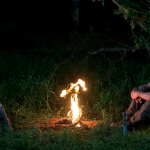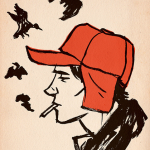1. James Davison Hunter, To Change the World: The Irony, Tragedy, and Possibility of Christianity in the Late Modern World
James Davison Hunter, a sociologist at University of Virginia, provides a helpful and timely analysis of how American Christians tend to conceive of and participate in “culture.” The book begins by laying waste to the cherished evangelical notion that culture resides in the hearts and minds of individuals. Hunter is equally critical of the Christian Right (Dobson, Pearcey, etc.), the Christian Left (Jim Wallis and company), and the Neo-Anabaptists (Hauerwas and Yoder) for conflating “public” with “political.” Against these over-politicized visions of culture—handily summarized as “defensive against,” “relevance to,” and “purity from” culture—Hunter instead advocates “faithful presence within” culture.
Hunter’s book is particularly strong in its critique of existing models of culture in American Christianity, though perhaps a little short on describing what faithful presence might actually look like. What I found particularly interesting is that, though Hunter is critical of postmodernism’s distrust of reality, he uses a lot of postmodern theory—especially Michel Foucault and Pierre Bourdieu—in his analysis of how cultures change. Perhaps Hunter’s book itself—written by a confessing Christian, primarily for a Christian audience, but published by Oxford University Press and making use of the best of what postmodernism has to offer—is an example of faithful presence within culture. -Carissa Smith
2. Jay-Z, Decoded
Decoded is an artistic experience. The cover, the font, the photography, the layout, and the lack of formal chapters all have specific intent. The song lyrics, together with helpful explanations of key lines, are interspersed with stories of growing up in the projects and hitting it big with hip-hop. There’s a lot to like.
But what you will really come to love is Jay-Z’s thoughtful, articulate descriptions of his art and its place in the world. He forces you to appreciate hip hop and rap and those who developed it, and see how much they share with, say, the creators of rock and roll or blues. He gives the larger-than-life characters we see in entertainment news context and purpose, explaining why this is part and parcel of the entire experience. More than anything, he shows you that his art, like others, comes from internal struggle and true experiences.
I came away unconvinced in several areas, but even so my view of that world was radically changed by this book. It has a lot to say about art in general, and brings tremendous insight to hip hop and rap in particular. It’s well worth your time to experience it. -Ben Bartlett
3. Connie Willis, Blackout and All Clear
Connie Willis is the author of several time-travel novels in which Oxford historians from the 2050s and 2060s travel back in time to research the past in person. One of these, To Say Nothing of the Dog (1999), is one of my Top 10 Fun Reads of All Time, and her fiction in general finds a fascinating balance between fate and free will: as a friend summarized the working of the space-time continuum in Willis’s novels, “everything you do matters, and everything you do doesn’t matter.” Blackout and All Clear, both published this year and originally intended to be a single novel (it grew), continue Willis’s combination of humor, carefully researched history, and theology embodied in time paradoxes—this time sending several historians back to World War II London.
In these two novels, everything Oxford historians—and Willis fans—thought they knew about the space-time continuum is called into question. As a result, the time-travelers are thrown into an interpretive frenzy, questioning the significance of their most miniscule actions and ultimately revisiting one of the crucial questions of time travel: do good intentions matter? -Carissa Smith
4. Nicholas Carr, The Shallows: What the Internet Is Doing to Our Brains
In the tradition of Neil Postman’s Technopoly, Nick Carr shows how our use of computers and the internet have changed not only the ways we read, think, and communicate, but has altered the shape of our brains. He focuses on research that shows that the effect of any repeated action is a change in the structure of the brain, dedicating more space to that action. You may think this “neuroplasticity”–the ability of the brain to change physically–only exists for children (which is what we’ve been told for so long), but the research in The Shallows shows that it’s true for adults as well.
So, is the internet making us stupid? Maybe “stupid” isn’t the right word.
We’re not losing intelligence. We just think differently. We value a different kind of originality, a different way of being informed, different types of relationships.
But the way we read online, and the way computers are “designed to distract,” causes us to expend a lot of mental energy just switching from task to task and trying to get settled–long before we take in any ideas–only to break out and switch to another task in short order. The result is a weakened ability to think deeply. That, in Carr’s estimation, is more than a minor problem.
Carr’s writing is direct, clear, and smooth, for the most part. A fairly enjoyable reading experience. For other (older) reading on subject, try Endangered Minds: Why Children Don’t Think…and What We Can Do About It (Jane Healy). -Charles Jones
5. George W. Bush, Decision Points
Throughout his time in the public eye, George W. Bush has been cast as an intellectual lightweight. I am sorry to report that this book will not destroy that notion. However, it will go a long way toward bringing nuance and reflection to a conversation that rarely has any. President Bush was neither a great man nor a great President, and you will see that in this book. At times, his pleading for your understanding and appreciation will even become uncomfortable. But he is and was a good man and a good President, and it is time we allowed him the dignity of being just that.
Decision Points is well worth reading because you come to appreciate the man, appreciate the gravity and confusion and competing interests he had to deal with, and appreciate his place in our country’s history. You will not be awestruck, but you will gain closure. You will not find any smoking guns, but there will definitely be some surprises of historical detail. And you will not revere the man, but you will, in some sense, be thankful for him and the role he took on. -Ben Bartlett
6. Catherine Fisher, Incarceron
While Incarceron was published in 2007 in the UK, for some reason it took three years to make its way across the pond. It’s worth the wait, however: among the young adult fantasy novels published (in the U.S.) in 2010, it’s easily the most intriguing. The setup is in some ways postapocalyptic: after the Years of Rage (gotta love that phrase), the Realm decided to start anew by sending off all its undesirables to Incarceron, a semi-sentient prison in an undisclosed location. Incarceron was intended to be a utopia, with the prison benevolently tending to the needs of all. The Realm, meanwhile, restored order by returning to an 18th-century society of manners, with strict period protocol (except for the wealthy, who cheat by using “skin wands” to erase their wrinkles). Each world views the other as perfect, though of course each is a different sort of dystopia.
Incarceron is extraordinarily well-paced, dispensing clues to important mysteries in just the right increments and just the right places. Dystopian young adult fiction may be a fad right now, but Incarceron goes deeper than most in raising questions about the interrelatedness of utopia and dystopia, and the role of human nature in bringing it all about. Unfortunately, the promise of these questions isn’t fully realized in Incarceron’s sequel, Sapphique (just published December 28 in the U.S.), but readers can still enjoy Incarceron and imagine their own resolution. -Carissa Smith
7. Carlos Eire, Learning to Die in Miami: Confessions of a Refugee Boy
Eire’s previous memoir, Waiting for Snow in Havana: Confessions of a Cuban Boy (which won the 2003 National Book Award for Nonfiction) is constructed as a series of proofs for the existence of God, but it won over readers of all faiths with its vivid descriptions of life in 1950s Cuba. Eire’s parents sent him out of the country at age eleven, as part of Operation Pedro Pan, and Waiting for Snow hinted at his subsequent life in America, but Learning to Die in Miami fleshes out that part of his story, recasting exile as a type of spiritual formation.
One of the major themes of Learning to Die in Miami is the tension between love of this world and detachment from it. Loss becomes the school for the soul, especially after Eire, as a teenager, returns to the one book he was allowed to bring with him from Cuba: Thomas à Kempis’ The Imitation of Christ, which advocates viewing all life on this earth as a kind of exile. Eire describes his first experience of reading and understanding this book as an entry into “Bizarro World,” where “Loss loses its sting. Pain gains its wings. Now becomes forever. Forever begins now, forever.” Learning to Die may not be as lyrically written as Waiting for Snow, but it’s a poignant depiction of Christian conversion as both homecoming and exile. -Carissa Smith
8. Tom Bissell, Extra Lives: Why Video Games Matter
Some of the most significant works of nonfiction are often looked at derisively or with little sense of import when they are first released, often because they are viewed to be overly optimistic, naive, or speculative about certain subjects or ideas. Extra Lives is certainly one of those books. Subtitled “Why Video Games Matter,” Extra Lives manages to strike a balance between objective analysis and subjective personal reflection, between cheering on a medium and pointing out some of its unique flaws. It’s an important book for Christians to read because it speaks of the inevitable influence a growing medium will have on individuals and culture going forward. It speaks both to the likely dangers and the hopeful possibilities of the medium. It may seem strange and speculative now, but the further into the decade we get, the more the book will ring true. -Richard Clark
9. Brett McCracken, Hipster Christianity: When Church and Cool Collide
Brett McCracken’s book about the collision of “church” and “cool” caused quite an uproar here at CaPC a few months ago. It seems that his description of “hipster Christians” hit a little close to home for many of our writers and readers, who speculated that he was basically an old guy complaining about “these kids today.” McCracken, a 2005 grad of Wheaton College, doesn’t really fit that description, and that fact gives his criticism a bit more weight.
In Hipster Christianity he sets out to describe the modern nature of hip (rebellion for rebellion’s sake), give some (imprecise) boundaries to the category “Christian hipster,” explain what the hipster church looks like, and discuss what this brand of faith might mean for the church. It’s the second of these goals that caught the most ill-will on these virtual pages. The most common complaint was that his description of Christian hipsters is too broad to be useful, that it simply describes 20-something Christians. I found that it described a particular type of 20-something—yes, generational difference plays an important role, but it’s not everything.
If you recognize yourself in his description, don’t feel insulted by the term “hipster” (McCracken calls himself one, after all), and you’ll be able to see some valuable cultural and ecclesiological insight into the nature of affluent, college-educated, largely white, urban and suburban Christians…more easily referred to as “Christian hipsters.” -Charles Jones
10. Robert Cording, Walking with Ruskin
Robert Cording has been one of my favorite contemporary poets since I discovered his poem “Common Life,” which discusses Augustine, the Road to Emmaus, and flatulence—all in twenty-some lines. Cording’s new volume of poetry, Walking with Ruskin, similarly combines the sacred and the mundane in unexpected ways. Even if you don’t know much about poetry, Cording’s poems tend to be fairly accessible because of their narrative approach, as well as their immersion in the everyday.
The poems in this volume take as their subject matter a mother’s grief for her child, looking though Czeslaw Milosz’s glasses (literally), aging, taking a walk with a dog, and observing woodpeckers, swallows and starlings. One particularly moving poem describes a neighbor’s madness–or is it wisdom?–in repeatedly and painstakingly decorating her mailbox, in spite of the fact that teen vandals will just knock it down again. Above all, the poems in Walking with Ruskin celebrate the virtue of attentiveness to the created world around us. -Carissa Smith











